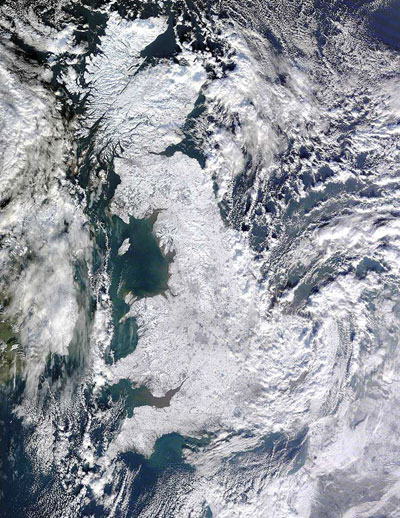In early January, websites started publishing a wonderful satellite image of a snowy British Isles, the coast crisply delineated and the land mass frosted wholly white. It looked so unreal that I naturally assumed it was fake, a snide Photoshopped exaggeration skewering the nation’s recent weather-induced attack of the vapors.
The image was real. The snow arrived and we were, briefly, paralyzed. According to the New York Times, London is “a city known for its low tolerance for snow.” Modern Britain, it would seem, is a country with a low tolerance for meteorological extremes of any kind; heat, cold, rain, fog, snow, ice, wind, floods, and hurricanes. All threaten to induce transportation breakdown, the overloading of the health care system, the closure of schools and—most importantly of all to the meteorological doom-mongers in the media—a fatal rupture in the economy.
It’s little wonder that the foreign reports focus so gleefully on the backbiting and hand-wringing that greets unexpectedly intense spells of seasonal weather. “Ola de frío provoca problemas en Europa” [“Cold snap causes trouble in Europe”] read the headline on a Spanish-language newspaper, paired with an image of a traditional British red telephone box in the snow.
The story goes like this: Weather happens, things fail. Politicians, national and local, savage each other for their lack of readiness. Newspaper columnists either praise or lambast the absence of stiff upper lip and bulldog spirit (adjust according to political affiliation).
For much of the British Isles, it really wasn’t so bad. In the day and a half or so that I’ve been toying with these paragraphs, there’s been a second major snowfall in London, with two centimeters settling overnight, fattening the contours and shapes of our small town garden into an unfamiliar landscape. But in just a few hours it had started to melt into an inelegant slush, falling in heavy lumps from the bowed stalks of bamboo, forming messy translucent puddles. Then it rained hard for a night. Now there’s very little reminder that the snow was ever here at all.
Naturally, such a metropolitan perspective is skewed. We’ve got it good here. Snow doesn’t stick to well-trafficked pavements or properly gritted roads; it only piles up in side roads, parks, and half-empty car parks. Elsewhere, on higher ground and in the remoter parts of the country, more acute problems remain. The snowfall was thicker, the first thaw never happened, and thick ice has emerged as a major obstacle. Injuries—even deaths—have been attributed to falls and exposure. The contrast makes for a simple illustration of London-bias I seem to have subconsciously adopted; if it hasn’t happened in the capital, it is best ignored.
Given the national obsession with the weather, there should be a thousand words for slush, with its rich palette of sooty greys and blacks, striated with the fat tire tracks of buses. But the reality is that once snow actually arrives and makes an impact, the inevitable grumbling begins.
When the next blizzard sweeps in on the Siberian winds, will Britain be any better prepared? I doubt it. Sheets of black ice might be inconvenient and dangerous, but the natural world is mercifully benign when it comes to the British Isles. Given that untold misery an be so casually wrought upon hundreds of thousands of people around the world, British grumbling about a few inches of snow seems pathetically parochial.
When the right kind of snow falls, and settles, rather than smears, across its sidewalks and squares, London can look magnificent. In the dark, the flurries of chunky flakes formed little galactic swirls as they caught in the sodium-yellow glare of the streetlamps. The whiteness makes the great expanses of park flow into the surrounding streets, while the deadened flow of traffic brings about an uncommon calm. There are few things more evocative than the morning silence of snow, a hush that it is only deciphered when one opens the curtains to discover the world has been quietly redrawn.
Last weekend I had to head east out of town, an hour or so across country to catch a North Sea ferry. It had seemed like a foolish venture earlier in the week, when the first snowfall still lay relatively thick on the ground. The Met Office—the 150-year old government agency that aims to chronicle, chart and divine the weather, making it an institution the British public either rails against or follows ardently, depending on its mood—was busy issuing weather warnings. But the trip became slowly less improbable. The thaw hastened, and by late Sunday night London was practically snow-free.
Arriving with half an hour to kill before the boat departed I drove into the small port of Harwich. The main roads were clear, but after a couple of GPS-induced twists and turns led me down a side street, I came up against the first proper challenge of the winter. The pavement was white with snow, deeply furrowed and on a slight incline. It looked exciting.
I turned left and crunched onto the soft surface. There was a shimmy from the rear end as the rear wheels started to spin and a warning light flickered on the dashboard. After travelling a few feet, it occurred to me that I might actually be about to get stuck, 80 miles from home and barely five minutes from my actual destination, simply because of idle curiosity and a sense of urban invincibility.
After several hundred nervous yards the snowy road finally gave way to cleared tarmac and my little snow adventure was over. In retrospect, my split second of yearning for a frisson of danger summed up the national mood: been there, done that, now let’s move along quick.



